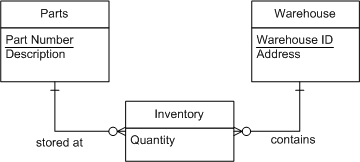When you have attributes associated with a relationship, rather than an entity, you can change the relationship into an entity. This situation sometimes arises with many-to-many relationships, when you have attributes that are particular to the relationship and so you cannot reasonably add them to either entity.
Suppose that your parts inventory is located at a number of different warehouses. You have drawn the following diagram.

But you want to record the quantity of each part stored at each location. This attribute can only be associated with the relationship. Each quantity depends on both the parts and the warehouse involved. To represent this situation, you can redraw the diagram as follows:

Notice the following details of the transformation:
Do not add either a Part Number or Warehouse ID attribute to the Inventory entity. Each entry in the Inventory entity does depend on both a particular part and a particular warehouse.
| Send feedback about this page via email or DocCommentXchange | Copyright © 2008, iAnywhere Solutions, Inc. - SQL Anywhere 11.0.0 |